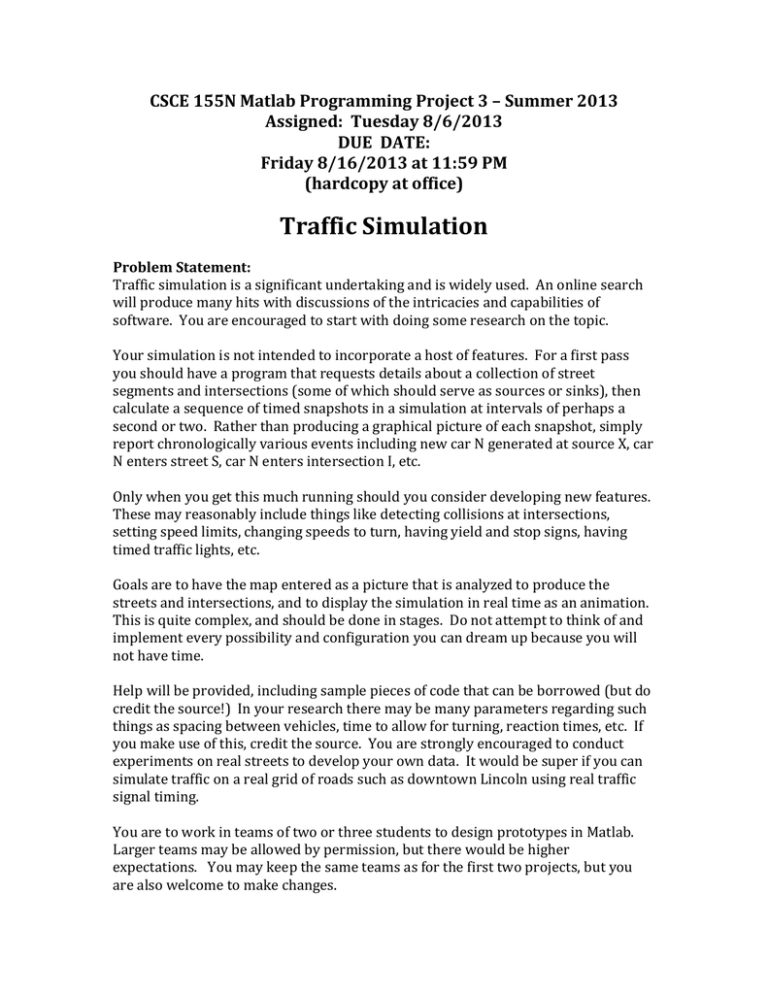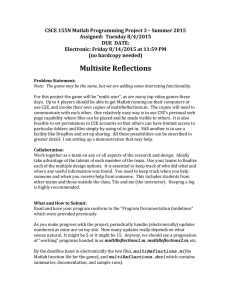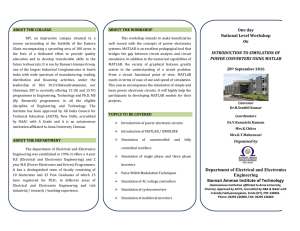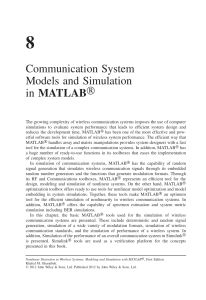CSCE 155N Matlab Programming Project 3 – Summer 2013
advertisement

CSCE 155N Matlab Programming Project 3 – Summer 2013 Assigned: Tuesday 8/6/2013 DUE DATE: Friday 8/16/2013 at 11:59 PM (hardcopy at office) Traffic Simulation Problem Statement: Traffic simulation is a significant undertaking and is widely used. An online search will produce many hits with discussions of the intricacies and capabilities of software. You are encouraged to start with doing some research on the topic. Your simulation is not intended to incorporate a host of features. For a first pass you should have a program that requests details about a collection of street segments and intersections (some of which should serve as sources or sinks), then calculate a sequence of timed snapshots in a simulation at intervals of perhaps a second or two. Rather than producing a graphical picture of each snapshot, simply report chronologically various events including new car N generated at source X, car N enters street S, car N enters intersection I, etc. Only when you get this much running should you consider developing new features. These may reasonably include things like detecting collisions at intersections, setting speed limits, changing speeds to turn, having yield and stop signs, having timed traffic lights, etc. Goals are to have the map entered as a picture that is analyzed to produce the streets and intersections, and to display the simulation in real time as an animation. This is quite complex, and should be done in stages. Do not attempt to think of and implement every possibility and configuration you can dream up because you will not have time. Help will be provided, including sample pieces of code that can be borrowed (but do credit the source!) In your research there may be many parameters regarding such things as spacing between vehicles, time to allow for turning, reaction times, etc. If you make use of this, credit the source. You are strongly encouraged to conduct experiments on real streets to develop your own data. It would be super if you can simulate traffic on a real grid of roads such as downtown Lincoln using real traffic signal timing. You are to work in teams of two or three students to design prototypes in Matlab. Larger teams may be allowed by permission, but there would be higher expectations. You may keep the same teams as for the first two projects, but you are also welcome to make changes. Collaboration: Work together as a class on any or all aspects of the research and design. Ideally take advantage of the talents of each member of the team, but recognize that each is responsible for the entire project! This means being prepared to answer questions on the code even if your allocated task was to write the report. It is essential to keep track of who did what and where any useful information was found. Record each time you helped someone else and each time someone helped you. Keeping a log is highly recommended. Note that Piazza keeps a record automatically! You will earn credit for all the help you can provide to the class. Share your research. Share your techniques for doing the simulations. Share your discoveries of how to do image processing and animation with Matlab. You may wish to meet as a class to assign research tasks! It is by working together that this project will be successful. Project 4? Rather than rework one of the first two projects, you may choose to implement GUI with event driven programming into this project and simply hand it in once! What and How to Submit: Read and have your program conform to the “Program Documentation Guidelines” which are online. Prior to the deadline hand in electronically versions of your (functioning) programs as they are developed top-down and as features are implemented. Number the versions similar to the way the various game projects are numbered on my class web site: traffic1.m, traffic2.m, etc. By the deadline hand in electronically the two final files, traffic.m (the Matlab script file for the game), and traffic.doc (which contains summaries, documentation, and sample runs). Only one copy per group needs to be submitted – it does not matter who does the handing it. In class the day after the deadline, hand in the hardcopy version, stapled together with the cover page in front. Each team member should electronically on his/her own account submit his/her own analysis of the relative contributions of all the members toward the project. This is in addition to the acknowledgement section of the main report. Assuming allocation is fairly even, all will receive the same grade. The Word document should contain the following, all carefully labeled: Cover page with name(s) and the account under which it is submitted, title, date submitted, etc. A discussion of the features you implemented in the project. Describe how they work and what Matlab options were used to program them. This should be at a fairly high level, not a line-by-line analysis of the code. An “instruction manual” that a non-programmer can use to run the simulator. An annotated cut and paste sample dialog of the running of the program. (Hint: Use the ‘diary’ command and/or capture screen shots.) A discussion of the testing that was performed. This should include testing of each component as it was being built, and testing of the final program ensuring that it works properly under a comprehensive range of conditions. An annotated cut and paste of a sample dialog, demonstrating how your program responds to extreme and faulty input. (This could be combined with the previous section.) Acknowledge all collaborations (both internal to the team and external), detailing what each person contributed individually, and what was done jointly. Indicate approximate percentages of the work contributed by each person in design, coding, testing, documentation, and report preparation. Grading Criteria: (subject to some modification) Program functions as intended – 30% Program logic is well designed – 20% Documentation guidelines are followed – 10% Handin Documents formatted and arranged as specified (this includes the sequence of earlier versions!) – 20% Testing is comprehensive – 10% Quality of the user’s manual – 10% Note that helping others will earn credit in the 10% Participation & Misc. category (as indicated in the syllabus). Attendance is worth a couple points; doing the PAT test is worth a point; doing work beyond the expected is worth a couple points; helping others is worth several points, perhaps enough to raise your final grade.








